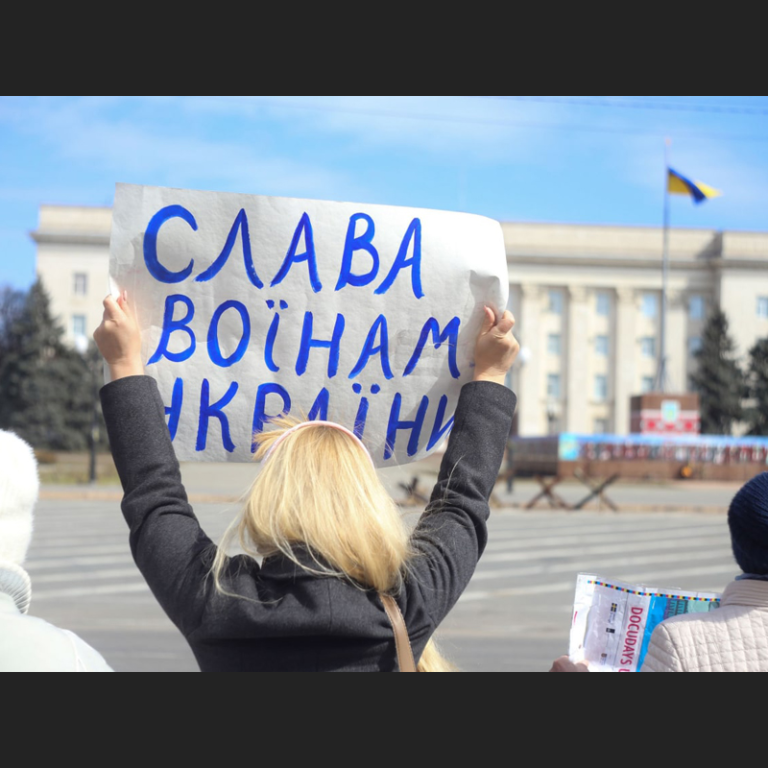
Kherson and the entire Ukrainian South was one of the first to take a hit from the Russian army. At the time of the publication of this material, Kherson remains under the temporary control of the invaders for more than five months already.
Ukraїner records the heroic history of the resistance of Kherson locals, who did not give up even after the armed dispersal of their peaceful rallies against the occupation authorities. Citizens are doing everything possible to prevent the Russian Federation from seizing their city according to the methodology that the aggressor country has repeatedly used to appropriate foreign lands. In this article, we recall how events have developed in Kherson and nearby villages since February 24, and how the South is fighting back.
The territory of the Black Sea steppes between the Dniester River in the West and the middle course of the Volga River in the East was once called The Wild Field. Life here ran in its own special, steppe way. It was a space where until the last quarter of the 18th century only nomads, Crimean Tatars, and Kozaks lived and gradually developed these territories.
Even back then, the Russian Empire was obstinately pursuing its predatory intentions towards other lands. In the 18th century, having won the Russo-Turkish War, it captured the Crimean Peninsula. It also developed a plan to change the ethnic dempgraphics of the Crimean Khanate, which at that time occupied the entire territory of two southern regions of Modern Ukraine: Tavria and Prychornomoria. At that time, the Russian Empire had two goals. The first goal was to “dissolve” the local identity of the inhabitants of the territory of tPryazovia and Tavria, but having exhausted human resources in the war Tsarist Russia simply had no one to send there. The Russian Empire’s second goal was to oust the Kozaks. Catherine II liquidated the Zaporizhian Sich in 1775. Therefore, from the Crimea to the Azov Sea and Tavria there were Greeks, Armenians, Georgians and Bulgarians, who began to live there along with Kozaks.
The Russian Empire called the vast territory of the present-day Azov coast, the Black Sea coast, and Tavria – the Tavria Governorate, or Novorossiya. Since the beginning of the 19th century until the first half of the 20th century, Russians have created ridiculous myths about these territories and Ukrainians. For example, they said that the steppe lands were developed thanks to the Russian Empire, and they spoke of the “liberation” of Crimean Christians from the influence of Islam.

220 years later, the Russian invaders, who came to the territory of Ukraine through the Crimea in 2022 are again drawing up a map of the Tavria Governorate. However, they either do not know, or have pretty much forgotten, what freedom-loving Ukrainians they will have to deal with.

Before the great invasion
2014 was a turning point for all Ukraine due to the Russian invasion of the eastern regions, the occupation of Crimea, and the Revolution of Dignity. It was also not easy for Tavria and the Black Sea region. Certain events that preceded the Revolution of Dignity were key in Ukraine’s struggle for a pro-European course of development. These events include a “march” to «The Party of Regions» Office (a pro-Russian political party), organised by local “anti-Maidan” authorities, which voluntarily and forcibly drove employees of budgetary institutions to attend. This was an attempt by the separatists to seize the Kherson regional state administration. This attempt was repelled by local self-defense, and the election of a new mayor Volodymyr Mykolaienko. 8 years later, Volodymyr Mykolaienko will be captured by the Russian invaders. During the filming of a story for the so-called Izvestia TV channel, he expresses his pro-Ukrainian position, calling Roman Shukhevych a hero. The plan to form Novorossiya from Kherson Oblast and join it to the Russian Federation under the auspices of the “Russian world” failed. On Freedom Square in the centre of Kherson, the bronze Lenin monument was replaced with the Heroes Of The Heavenly Hundred (over 100 people who were peacefully protesting again the abuse of power and were murdered in February 2014 on the Maidan (Independence Square) in the centre of Kyiv) stela. In subsequent years, people in and around Kherson lived their usual life: they developed small and medium-sized businesses, harvested crops, built up infrastructure and local tourism, and engaged in art. However, now their region was adjacent not to the free, but to the temporarily occupied Crimea.

February 22-23. The clouds are turning black
At the Chonhar checkpoint, located on the administrative border with Crimea, artillery shots can be heard and lights can be seen flashing from the peninsula. Later it will turn out,that this is how the Russian border guards wanted to “warn Ukrainian companies so that they would run away from their positions.
Traffic through the border checkpoint is stopped by the Russian Federation for no specific reason. Russian multiple launch rocket systems (MLRS) and self-propelled artillery units are being sent to mainland Ukraine.

February 24. A full-scale war

03:45 — The enemy starts simultaneous traffic through the Kalanchak and Chonhar checkpoints. The first to take up the fight are the defenders of the south, including the 59th Motorized Brigade named after Yakiv Handziuk, the Border Guard Service, intelligence, and other units of the Armed Forces of Ukraine.
Approximate time of further development of events:
6:20 — The Russian military launches a missile strike at the “Kherson” International Airport (Village of Chornobaiivka).
9:29 — There is fighting in the settlements of Velyki Kopani and Ivanovo.
11:30 — Russian troops land at the Antonov Bridge, and battles for this bridge at the north-eastern border of Kherson begin.
A local resident (his name is not given for security reasons) tells us:
— I went out to visit my mother. I rode my bike to the corner, and at that moment at the level of power poles (power lines. — ed.) five Russian helicopters flew over me. In the distance, I could hear aircraft, artillery installations thundering. I came home because it was scary and completely unclear what would happen next. Different aircraft were visible in the sky every minute.
February 25-28. Attack
For the next few days, the village of Antonivka is under constant Russian fire, and the fighting for the Antonov bridge does not stop, as well as the fighting on the Crimean Highway. Both sides repeatedly fight for the bridge. At the cost of superhuman efforts of defenders of Kherson and the surrounding territories, it remains under Ukraine until February 28, after which it finally falls under the control of the invaders.

Many invaders were eliminated near the town of Oleshky. There are battles for Nova Kakhovka, the local hydroelectric power station is controlled either by the Ukrainian Armed Forces, or by the invaders. In the east of the region, Henichesk is occupied, and Russian troops are moving towards Berdiansk.
March 1–4. Russian terror
On March 1, Russian troops entered Kherson and Nova Kakhovka. The last attempt to stop the invaders is made by the Territorial Defence Unit of Kherson. Without any weapons, except for one hand-held anti-tank grenade launcher (RPG) and “Molotov cocktails”, local men went out towards the tank column of the invaders. Unfortunately, all of them died in the Lilac Park (it is also called the Oil Workers’ Park). Their memory plays a critical role in the region’s continued resistance: their sacrifice was not in vain.

The Russian military is acting very cruelly: they fire at residential areas, shoot people in the streets, install “tripwire mines” in front of shop entrances, and kill anyone who seems suspicious to them.
Soldiers of the Armed Forces of Ukraine are forced to retreat from the city to save the lives of military and civilians. The occupiers visit the city council and allow the mayor’s office to function only if they comply with their requirements about the coexistence of citizens with the Russian military. For example, the city restricted the movement of cars and could check the contents of the boot at any time. Also, citizens were forbidden to walk in more than twos, and the military had the right to stop anyone. The mayor of the city Ihor Kolykhaiev was forced to accept conditions of the Russian occupiers, but they do not keep their promises and begin a humanitarian blockade of the city.


Instead of Ukrainian television, they are beginning to broadcast Russian propaganda, capturing a local TV tower. According to the invaders, this is the main thing that can make people believe in their version of events. On the same day, mobile communication disappears for several hours: as it turned out, at that time the invaders were shooting a story for their television about providing Kherson residents with humanitarian aid. However, the locals did not agree with this and even without communication began to resist: they drove away from the trucks on the main square a few people who wanted to receive this demonstrative handout. The propaganda plot failed.
March 5. Protest of Kherson residents
After the spontaneous peaceful protest against Russian humanitarian aid persisted, and communication resumed, Kherson residents committed a heroic act. Despite the direct threat to life and health, they organized themselves and went to the multi-hundred-people rally against the occupation authorities. People carried flags and shouted “Go home!”, “Glory To Ukraine!”. They sang the national anthem and pushed back Russian equipment. They showed the whole world that they are not going to give up and wait for the invaders’ good will to leave.

It was this first major protest that launched a wave of rallies in other temporarily occupied cities and villages of the region in Melitopol, Henichesk, Berdiansk, Tokmak, Nova Kakhovka, Beryslav, Oleshky, Skadovsk, etc. It was a push that turned the once not very active region into a hotbed of powerful resistance — literal and informational ones. The “Photo of a resident of Kherson” is of a person who with the flag of Ukraine jumped out onto an enemy armored personnel carrier. This photo flew around the world.

March 6 – 21. End of patience
Kherson’s residents continue to live under the slogan Vive la Resistance! (from French “Long Live The Resistance”). Almost daily protests continue despite the fear and understanding that the soldiers of the Armed Forces of Ukraine still cannot counterattack. People are starting to disappear more and more often. They are “packed” into cars on the streets, or Russians come to their homes at night and take them out “to have a conversation”. Journalists, ATO participants, police officers and volunteers were abducted. Among them was the rector of the Church of the Most Holy Theotokos Serhii Chudynovych (Father Serhii), who held a funeral service for the victims in the Lilac Park.
At first, Father Serhii said that the Russian military treated him normally. However, after the evacuation, he was able to explain that telling the truth was dangerous, in fact, he was beaten, threatened, and forced to cooperate.
Applying the method of «carrot and stick» the occupiers moved from coercion and intimidation to the already well-known fake role of “liberators”. They offered humanitarian aid and medicines to Kherson residents, although they themselves arranged a humanitarian blockade of the region. At the same time, the Russian military constantly reminded the Ukrainians that they were allegedly abandoned and the “Kyiv authorities” no longer needed Kherson and the nearby villages. So, Nataliia Poklonska, a former prosecutor of the Autonomous Republic of Crimea, was photographed in camouflage allegedly on the territory of the region and told about the delivery of Russian humanitarian aid. According to her, the Ukrainian side allegedly threatens people and says that they will set fire to their homes if they take it.

However, the intimidation did not stop the residents of the region. They supported each other. They delivered aid on their own, collecting leftovers in warehouses and escorting single loads to their destination. They managed to transport from the territories of the Black Sea region and from Zaporizhia and Podniprovia regions.
The winner of the popular TV show “Master Chef” Pavel Servetnyk along with his “Breadman” team raised funds and baked bread for free together with the Kherson bakery, while there was such an opportunity.
Some chickens and eggs from Europe’s largest Chornobaiivka poultry farm, which worked without electricity as a result of Russian shelling, were distributed by employees to people, neighbouring farms and employees of the business. Through criminal actions of the Russian Federation, over 4 million birds died, and their carcasses could not be properly disposed.
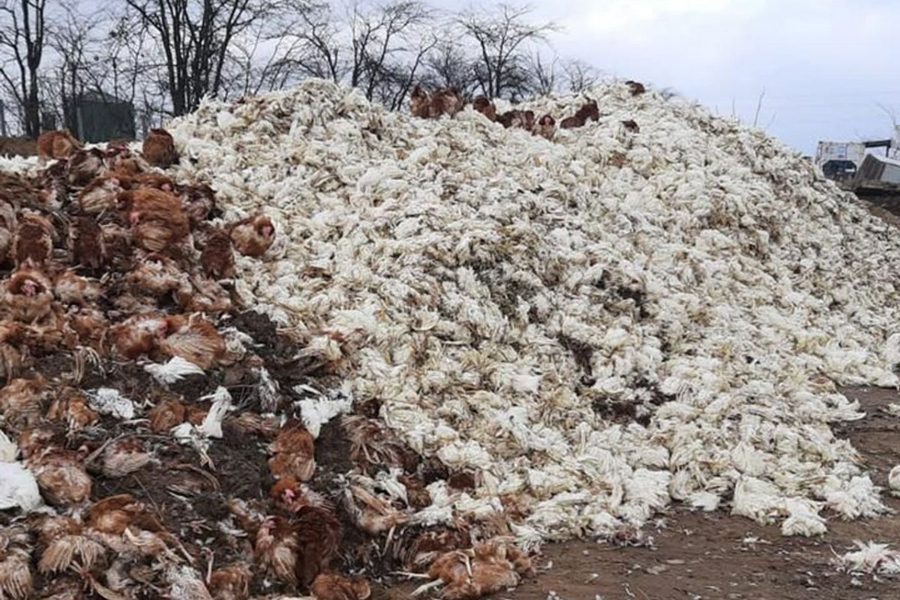
Photo: WSJ.
The resistance of the locals confused the Russians. Kakhovka journalist Oleh Baturyn, who was also held captive, remembers in an interview with Novaya Gazeta:
— After another interrogation, they (the Russian military. — ed.) opened a window, and there at that time a rally was being held on Freedom Square, and it was just grandiose. I felt the confusion of those who questioned me. They said, “We’ve come to protect these people, and they’re walking around shouting something.”
The Russian military could not morally withstand such humiliation and crossed the line on March 21. The Kherson art critic became an eyewitness to these events. In the morning, she was going to a friend’s birthday party and decided to buy a gift. Passing by the rally, she got caught on a forceful dispersal of the protest:
— Shooting starts, explosions, the siren turns on (I understand that I need to run straight to the Museum (Museum of Modern Art in Kherson. — ed.) — the nearest point. There I will learn more: invaders wrote on the monument to the heroes of the Heavenly Hundred “Armed Forces of Ukraine murdered the children of Donbas”. Our people began to remove that inscription. Orcs threw stun and tear grenades at people and started shooting. There is a wounded man, but there are no details yet on how injured he is. The rest were beaten with machine gun butts and boots. The Russians took away three protesters (according to the official data, four people were injured. — ed). Well, we knew it would happen.
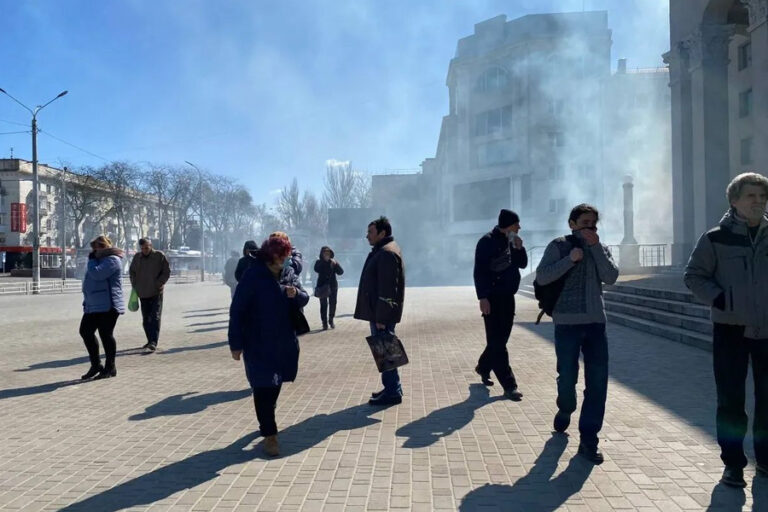
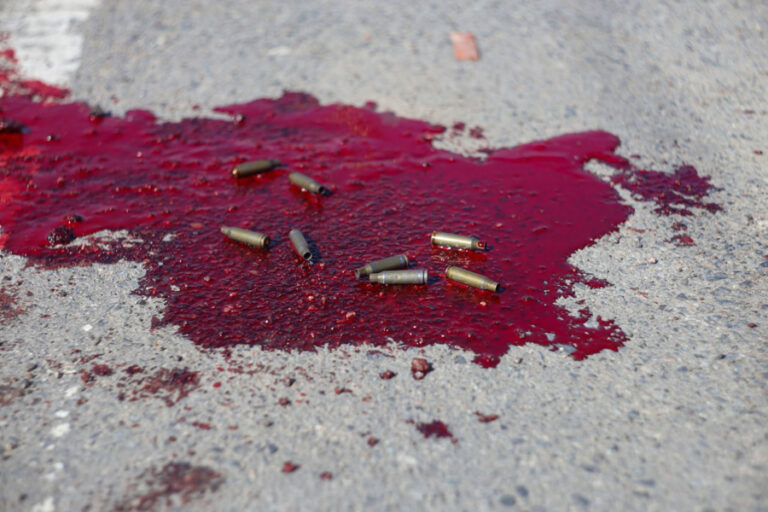
slideshow
March 21 – April 30. Less and less oxygen
The Russian military seems to be going crazy. Violence is increasingly being used and people’s freedoms are being restricted. They fire at the peaceful rallies of Kherson residents again and again. Protesters are indiscriminately beaten with batons, and stun grenades are used against them. Invaders capture the Kherson City Hall building and remove the Ukrainian flag. Then they appoint new heads of the region — the locals call them “gauleiters” — a term from the time of the German occupation regime, which is what the heads of administrative-territorial units were called then. The invaders appoint collaborators as new leaders: ex-governor of the Kherson City Council Volodymyr Saldo and Oleksandr Kobets, who was unknown to anyone at that time. Kyrylo Stremousov, an odious activist who “became famous” for his pro-Russian and anti-vaccination statements, anti-Ukrainian rallies organised back in 2014, and even murder.

At this time, the media will publish the first information about the bloody crimes of the Russian military in Bucha, Hostomel, and Irpin. This made it difficult to promote the propaganda myth of “liberation from the Kyiv regime”, so the invaders in Kherson changed their strategy. They began to behave defiantly friendly and ask the locals again: “We don’t offend you, do we?”. It is clear that the invaders’ hopes for the Kherson residents to fall for this were in vain.

Russian soldiers also began distributing leaflets justifying their actions and calls to stop resisting. By the way, such printed informational materials their unfortunate brothers also used in other regions of Ukraine.
During the same period, a significant part of the population independently evacuated from the region — some by their own transport, and some on foot to the nearest areas where it is safer. People could not remain without money, or live and work with fear of constant shelling and restrictions on freedoms. Lack of electricity, water and gas, and problems with the supply of food and medicine — this is the kind of “Russian world” that was created by the invaders in Kherson. There was a completely safe route (from the personal experience of the author of the material. — ed.) through Crimea to Georgia and then to Europe. But not everyone dared and could use it, so they often chose the road through Snigurivka to Mykolaiv or through Davydiv Brid to Kryvyi Rih. This was not an official evacuation road (no “green corridor” was announced at the time of publication of this material). Getting to the border, where the Ukrainian military were located, could take 6-10 hours, and on the way there were more than 10 checkpoints — both Ukrainian and Russian.
For those who were going to leave, various sources and people who successfully evacuated advised the following:
– Delete all correspondence and photos on your phone that may express a pro-Ukrainian position.
– Answer the question: “Where are you going? Here it is safe”. Say, “To my grandmother’s on the controlled territory”.
– Take chips and cigarettes with you, which can be used as “currency” for the invaders.
– Cover valuables with food that Russian soldiers get distracted by.
– Cover pro-Ukrainian tattoos with other ones: for girls on visible places, and every tattoo for men (young men were undressed at checkpoints).
– Hide money in the car’s trim, but be prepared to pay about $200 for crossing the checkpoint.
– Do not quarrel, argue or be rude to the Russian military.
Russian soldiers robbed, beat, or abducted people for violating these rules.
There were regular cases when a column of cars was not allowed to pass through a checkpoint, or it was used as a “human shield” for transporting military equipment.
It seems that at this time, the “gauleiters” were increasingly thinking about various ways to seize Ukrainian lands. In their media there were references to the referendum on the formation of the so-called Kherson People’s Republic (KPR, the name is similar to the DPR and LPR), a referendum on joining the Russian Federation, restoration of the Tavria Governorate, which existed in the 19th–20th centuries and so on. To implement such a plan, foremost, people are needed, so the invaders decided not to let anyone out of the region.

Prohibition to leave the Kherson Oblast lasted until May 11. At the same time, people’s passport data was collected in all possible ways: in exchange for humanitarian aid, medical treatment, travel to the occupied Crimea or any other favour. In addition, they tried to appease people: until May 9, they hung posters with an invitation to get “50 grams of the frontline liquid courage and porridge”.
At the same time, the invaders carried out an enhanced de-Ukrainization of the territory. They dismantled the alley of Heroes of the Heavenly Hundred, coats of arms, and the inscriptions “Ukraine”. In their place they hung Russian flags and created Russian patriotic drawings on the walls. But at that time, the Ukrainian partisan movement was already operating in the city.

Partisans
The growing danger has jeopardized open protests. Residents of the region mostly cared about survival: getting food, medicine, issuing documents, and paying bills. Farmers who have put a lot of effort and money in their products were forced to sell them at home for a song to earn at least a penny. If the products were not sold in this way, they could be taken to the occupied Crimea for free. Part of the crop ended up on the sidelines because farmers who refused such “opportunities” were forced by the invaders to throw out the crop in the open air.
However, underground resistance of Kherson residents and nearby villages does not allow the invaders to remain calm. More and more often there are posters and images on the walls of houses with threats or patriotic statements, and some enemies no longer wake up in the morning. “Gauleiters”, after the partisans eliminated Russian collaborator Pavlo Slobodchykov in March, begin to move around the city with security guards and bulletproof vests. At night leaflets appear in different districts of Kherson (example 1, example 2, example 3), hinting to the rest of the collaborators that such a fate may befall them as well.
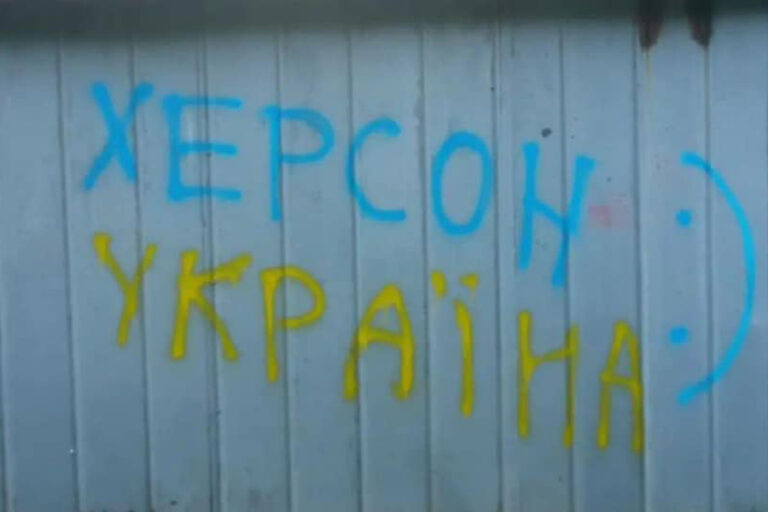

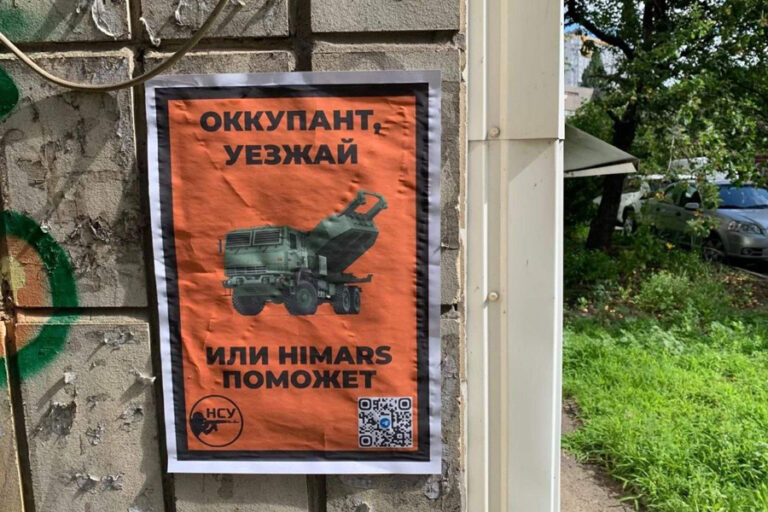
slideshow
People’s Deputy (at the time of the attempt) Oleksii Kovaliov, founder of the NGO “Nova Rus” Dmytro Savluchenko, head of the Chornobaiivska administration Yurii Turuliov appointed by the Russians and other traitors were added to the list of those who were brought to justice by the people.
Considering such a rebuff, the Russians resort to propaganda “creativity”. On the central square of Kherson, they organize a photo exhibition accusing Ukraine of killing children in the East for 8 years and shelling Donetsk in March 2022. This exhibition takes place in the same place where rallies were recently dispersed, terror was staged and rockets were launched in Mykolaiv.
However, even this does not help the invaders to achieve their goal. In an interview with the French international news television network France 24, accompanied by the Russian military, the trolleybus conductor boldly declares that she stands for Ukraine and wants Kherson to be free, as it used to be. At a meeting of teachers organized by the invaders, most refused to cooperate and left. It takes months to find collaborators who could replace the democratically elected government. Sometimes managers are appointed without their consent. For example, in Oleshky, a new so-called mayor was chosen only at the end of May.
At the end of April, there was a “Yellow ribbon” demonstration of non-violent resistance against the occupiers. People in Kherson began to hang up yellow ribbons on trees and railings. They wore them on their backpacks and clothing to express their pro-Ukrainian position and disagreement with the actions of the occupation authorities. The campaign continues until now. This is how Kherson residents support each other and hold the line of cultural resistance.

Russian soldiers find their flags thrown under their feet. Their propaganda materials are torn down, and propaganda signs are scratched out.
On May 30, Kherson residents and the surrounding villages found out that instead of Ukrainian mobile networks, they now have Russian ones. This happened due to the actions of Russian “network specialists”. SIM cards are offered on the streets in exchange for passport data, and the Internet service providers are forced to direct traffic through the Russian Federation. On the same day, in the city centre, a loudspeaker reported that Ukraine allegedly disconnected Kherson and nearby localities from its networks. However, Ukrainians know who is really destroying cities and villages, deliberately destroying infrastructure. Thus, residents in the temporarily occupied territories learn how to use a VPN.

The path to freedom
In the Russian Federation, occupation methods have been unchanged for a very long time. The order of stages may vary, but the essence is always the same:
– Assimilation of the military contingent into the lives of civilians for sabotage activities.
– Promotion of the “you were abandoned” narrative.
– Indicative provision of humanitarian aid simultaneously with its blocking in other territories.
– Total Russification of cultural life and everyday life.
– Economic blockade, coercion to cooperate with threats and lack of alternative ways to survive.
– Luring out personal data for pseudo-referendums.
– Freezing the internal conflict and using it to destabilize the situation.
This path has been followed by all the so-called People’s Republics created by the Russian army since the formation of the Pridnestrovian Moldavian Republic in 1992. This is very similar to an abusive relationship that is to suppress the will and force the victim not to resist.
All attempts by the invaders to convince the Ukrainians in the occupied territories that their authorities and defenders have left them to their fate are shattered by reality. Frontline cities (Mykolaiv, Kryvyi Rih, Zaporizhia) organize refugee reception centres, feed them, settle them, and help them to adapt to their new place. Volunteer organizations, for example, “Kotyky-patriotyky” (Patriotic cats), KhersON, Protection Foundation and others at the cost of superhuman efforts deliver medicines, food and hygiene products to the territory of temporarily occupied Kherson and surrounding settlements. Together with the locals, they are waiting for the return of the Ukrainian flag over the City Hall of Kherson.
Of course, many events and names of heroes will become known after the victory. And now the residents of the Ukrainian South resist the invaders every day, not giving up a single piece of their land without a fight.

